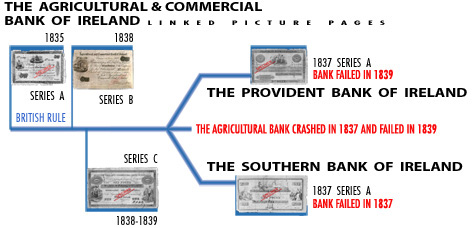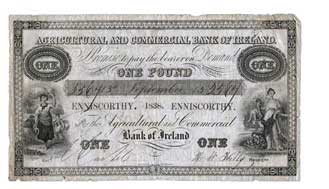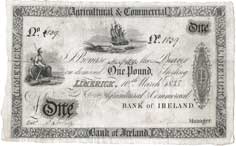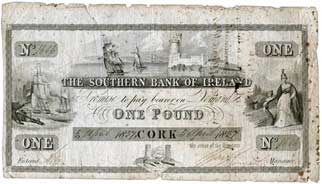

Agricultural and Commercial Bank: Series A 1835 - Series B 1838 - Series C 1838
Southern Bank: Series A 1837
Provident Bank: Series A 1837
First proposed as the National Commercial Bank of Ireland, the Agricultural and Commercial Bank was founded by Thomas Mooney as a bank for farmers and smallholders.
The 1824 Act allowed the creation of Joint Stock banks of note issue in Ireland. Prior to this the only joint stock bank in Ireland had been the Bank of Ireland, which had been established as a private joint stock bank by Royal Charter in 1783. All other banks were small private banks of six partners or less. An Act in 1825 allowed for public joint stock companies, and it was this which paved the way for the formation of large Irish joint stock banks.
The Agricultural and Commercial Bank was one of six newly formed joint stock banks post-1824, and it opened its first branch in Nenagh on 1 November 1834. In 1839 it had 44 branches plus a non-branch head office in 4 College Green, Dublin. There was considerable rivalry between this bank and the National Bank. The Agricultural and Commercial Bank issued three series of banknotes.
The bank was poorly organised, badly managed and incompetently run. It expanded too fast for its capabilities. It also opened branches in Ulster, a province already well served by strong banks, in the Northern Banking Co. and Belfast Banking Co., which the Agricultural and Commercial could not compete effectively against. However, its most critical shortcoming was its capital base.
Unlike other Irish banks, one of its founding ideals had been that of an 'Irish bank for Ireland'. Because of this it relied solely on Irish shareholders and had no English capital base to draw upon in times of crisis as did the other Irish banks. This was to prove fatal to the bank.
There was a run on the National and Agricultural banks in 1836 during a financial crisis at the time. Although the National fared well, some of the branches of the Agricultural stopped payment on its notes in November 1836 due to a lack of readily available cash. Although it had failed in liquidity, the bank was, nonetheless, solvent and it resumed payment on its notes on 23 January 1837.
Following continual difficulties in liquidity and much acrimony, the Agricultural and Commercial again suspended payment on 19 April 1840. The bank was not bailed out by the Bank of Ireland, which at times had assisted other banks when necessary and feasible, and it never resumed operations. Its debts were finally paid off by ca.1851.
The Provident Bank was founded in Dublin by Thomas Mooney, founder of the former Agricultural and Commercial. Despite being in Dublin, the bank was able to issue banknotes as it had fewer than 6 shareholders. It was constituted in such a way that it could draw on funds from outside of its shareholder base.
The bank was intended as a farmers’ bank and only ever had one office. It failed to raise sufficient capital for its activities and ceased operations in December 1839, with its owners being adjudicated bankrupt on 14 October 1840. It appears that the vast bulk of its banknotes were paid off by April 1841.
The Southern Bank of Ireland was founded in Cork in March 1837 by some former officials of the Agricultural and Commercial's Cork branch, lead by its Manager, William Mitchell. The Bank lasted approximately two months in business, and appears to have operated on the fringe of legality. It issued one series of banknotes, but had little in the way of funds to back them.



References
Images of banknotes on this website of the Agricultural and Commercial Bank of Ireland, Southern Bank of Ireland, and Provident Bank of Ireland are from the following sources, as noted under each image on the linked picture pages: Central Bank of Ireland; private collections; auction catalogues: Noonan's (DNW), London, Spink, London, Whytes, Dublin.
1. Auction catalogue, Noonan's (DNW), London. Important Collection of Irish Paper Money formed by Bob Blake (Part I), 2 Oct 2008.
2. Auction Catalogue, Noonan's (DNW), London. Important Collection of Irish Paper Money formed by Bob Blake (Part II), 14 March 2009.
Irish Joint Stock Banks of Note Issue from 1783
Contemporary Forgeries of Early Irish Banknotes ca1800-1930
Irish Three Pound Notes of the Joint Stock Banks
The Transition of Irish Currency, Irish banknotes 1918–1928
The Partition of Irish currency, Irish banknotes 1928–1930